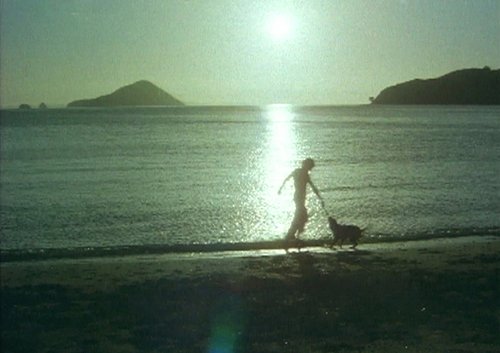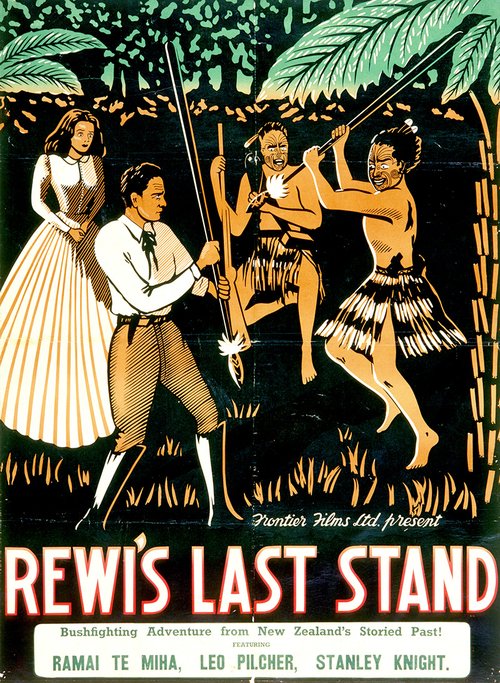
October 2016 saw the 120th anniversary of the first public film screenings in New Zealand. To mark the anniversary, a season of films that shaped New Zealand were screened at Ngā Taonga Sound & Vision's Wellington cinema.

Rewi's Last Stand / The Last Stand
(Rudall Hayward, 1949)
On 13 October 1896, New Zealand’s first public screening of a motion picture played to an audience at the Opera House in Auckland, as part of Charles Godfrey’s Vaudeville.
The new-fangled kinematographe of Professors Hausmann and Gow projected short films of moving life: a train pulling into the station, a dancing girl, beach and street scenes.
“Everything moved as though in life; in fact, it was life reproduced,” raved the NZ Herald (14 October 1896).
The film show moved south to Thames and Paeroa before Wellington got its chance on 28 October at the Exchange Hall, then Christchurch on 7 November during Show Week and Dunedin on 20 November.
"An electric knob is touched, and where all was darkness there appears an illumination, and Sandow 'the strong man,' not a picture, but Sandow in his habit as he lives, displaying every feature of his marvellous muscular power… every twist and twitch… every expression of his face… is reproduced with absolute fidelity to nature,” wrote Wellington’s Evening Post (27 October 1896).
"…of what infinite possibilities it is capable. Indeed the extent of these possibilities can hardly be suggested."
"New Zealand filmmakers and audiences both seized upon the technology. By the mid-1940s the average person attended the cinema 23 times a year," says James Taylor, programme manager at Ngā Taonga Sound & Vision.
"It was the beginnings of a technology and art form that has shaped New Zealand’s culture and identity. Over the past 120 years, audiovisual records – film, radio, television, audio and video recordings – have become the currency of modern culture and the primary records of the 20th and 21st centuries.
"Around 750,000 of these are now safely in our ever-growing collection, preserved and able to be shared with people now and in the future. That way, we make sure that these stories, art and records are never lost to New Zealanders."
To celebrate 120 years of cinema in October 2016, a season of iconic New Zealand feature films, plus films from the 1896 tour, screened at Ngā Taonga in partnership with Manatū Taonga Ministry for Culture and Heritage, supported by the NZ Film Commission.

Sleeping Dogs
(Roger Donaldson, 1977)
"This year the Ministry is supporting several national commemorations related to the New Zealand film industry," says David Butts, Manager of Heritage Operations at Manatū Taonga Ministry for Culture and Heritage.
"We are delighted to partner with Ngā Taonga Sound & Vision, supported by the NZ Film Commission, to mark the 120th anniversary of the first public film screening and to showcase the very best of New Zealand cinema."
Films That Shaped New Zealand ran from 12 to 22 October 2016.
It began with the 1940s feature Rewi’s Last Stand / The Last Stand and moved to classic features of the 70s and 80s such as Sleeping Dogs, Smash Palace and Mr Wrong as well as box office hits of more recent times such as Whale Rider and Boy.
Each feature was preceded by either Sandow the Strong Man or The Serpentine Dance, from the original show that toured New Zealand in 1896.

Mr Wrong
(Gaylene Preston, 1985)
Film and Programme Information
Rewi’s Last Stand / The Last Stand (Rudall Hayward, 1949)
A remake of his 1925 silent film of the same name, this is the film the pioneering director Rudall Hayward is best remembered for. It's based on the famous battle of Ōrākau, when Rewi Maniapoto and his 300 supporters resisted the advance of over 2,000 British troops during a siege which lasted for three days. Hayward intended the film as a tribute to the heroism of Maniapoto and his followers; today it stands as a tribute to the enterprise and fortitude of its writer, director and photographer.
Sleeping Dogs (Roger Donaldson, 1977)
"Smith is a man on the run, running from a broken marriage. Accidentally caught between two powers – a repressive Government and a violent resistance movement – he becomes a man alone... hunted and hostile, driven by the will to survive."
Sleeping Dogs was the feature directorial debut of Roger Donaldson and the film that launched the NZ Film Commission and the acting career of Sam Neill.
Mr Wrong (Gaylene Preston, 1985)
Gaylene Preston’s feature film debut "subversively reworked the familiar plot of the besieged woman." This taut, entertaining, thriller proved there was a local audience for films with female leads, feminist themes and which played with established genre conventions.
Smash Palace (Roger Donaldson, 1981)
“After the break-up of his marriage, a racing driver sets out to get back his daughter – at any cost." Roger Donaldson’s second feature film was a commercial success, establishing him as a world-class director and Bruno Lawrence as New Zealand’s leading man.
Films That Shaped New Zealand: A Compilation
A look at how New Zealand’s media has portrayed New Zealand cinema over the decades.

Boy
(Taika Waititi, 2010)
Boy (Taika Waititi, 2010)
The second feature from Taika Waititi moves away from the grim, dark topics that characterise much New Zealand cinema, with a story of coming of age laced with his characteristic light-hearted humour. It became the highest grossing New Zealand made film at the local box office, until it was replaced by his own Hunt for the Wilderpeople.
Once Were Warriors (Lee Tamahori, 1994)
Lee Tamahori’s brutal, unflinching feature debut stirred up as much controversy as it did success at the box office. Based on Alan Duff’s bestselling novel of the same name, it tells the violent, urban, love story of Jake and Beth Heke and featured stunning performances from its leading actors Rena Owen and Temuera Morrison.
Don’t Let it Get You (John O’Shea, 1966)
This feel good musical comedy from Pacific Films was their third feature, and one of the few made during the lean years of New Zealand filmmaking of the 1950s and 1960s. Featuring an all star cast, including Howard Morrison and Kiri Te Kanawa, on release it was publicised as "a tonic film that doesn’t let the blues get you. When it finishes, you feel as if the time has gone too fast and you leave the theatre wanting to see it all over again.
Sione’s Wedding (Chris Graham, 2004)
Reflecting the increasing influence of Pacific Island and Samoan culture in New Zealand, Sione’s Wedding is a feature from the comedic minds behind the Naked Samoans comedy group which: "brings the humour, life and colour of Polynesian culture to the big screen."
Goodbye Pork Pie (Geoff Murphy, 1981)
One of New Zealand’s most popular, enduring and iconic films, Goodbye Pork Pie was the first box office hit of the new wave of films made in the late 1970s and early 1980s. Director Geoff Murphy’s tale of two men on the run, in a small yellow mini, had an anti-authoritarian spirit and covered the breadth of the country, encouraging audiences across New Zealand to view the film. It became the first New Zealand made to gross over $1 million at the local box office (nearly $4.5 million today), and the car, and scenes from the film remain iconic today.

Patu!
(Merata Mita, 1983)
PATU! (Merata Mita, 1983)
Perhaps the most important documentary made in New Zealand, PATU! is a hard hitting view from the frontline of protests that engulfed the country during the 1981 Springbok Tour. Directed by Merata Mita, footage was supplied by a who’s who of New Zealand cinema. The result is a powerful, raw, example of agitprop and oppositional filmmaking, from a staunchly Māori and anti-racist perspective.
Utu Redux (Geoff Murphy, 1983 / 2013)
A restored and re-edited version of Geoff Murphy’s classic film Utu. Subverting the traditional Western genre, with a fictional story based during the Land Wars and featuring characters mixed from nineteenth century Māori leaders, the film was another box office and critical success. It was the first New Zealand film to be invited to the Cannes Film Festival, and after digital restoration by Park Road Post supervised by Murphy and Graeme Cowley in 2013 it looks better than ever.
Whale Rider (Niki Caro, 2002)
Niki Caro’s adaptation of Whiti Ihimaera’s novel of the same name is based on the universal theme of a coming of age story, but set within a specific cultural context of the East Coast Ngāti Porou legend of Paikea. While made by a Pākehā director, most of the cast are Māori, many from the local area, and the film is led by an astounding performance by Keisha Castle-Hughes who wasn’t yet a teenager at the time. The film is one of New Zealand’s most successful performers overseas, beaten out only by Sir Peter Jackson’s King Kong and The Hobbit / Lord of the Rings films.
Thank you to all the filmmakers who kindly gave their permission for Ngā Taonga Sound & Vision to publicly share their films, and to the NZ Film Commission for its support in supplying digital screening files.
For more background on the New Zealand screen industry please refer to this piece by Te Ara.